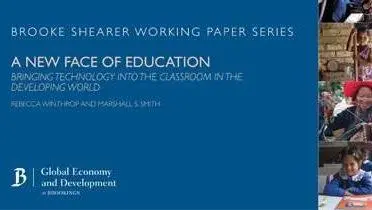INTRODUCTION
In the small village of Hafizibad in Pakistan’s Punjab province, a young girl is using her mobile phone to send an SMS message in Urdu to her teacher. After sending, she receives messages from her teacher in response, which she diligently copies by hand in her notebook to practice her writing skills. She does this from the safety of her home, and with her parents’ permission, during the school break, which is significant due to the insecurity of the rural region in which she lives. The girl is part of a Mobilink-UNESCO program to increase literacy skills among girls in Pakistan. Initial outcomes look positive; after four months, the percentage of girls who achieved an A level on literacy examinations increased from 27 percent to 54 percent. Likewise, the percentage of girls who achieved a C level on examinations decreased from 52 percent to 15 percent. The power of mobile phone technology, which is fairly widespread in Pakistan, appears in this case to help hurdle several education barriers by finding new ways to support learning for rural girls in insecure areas—girls who usually have limited opportunities to attend school and who frequently do not receive individual attention when they do. Often they live in households with very few books or other materials to help them retain over summer vacation what they learned during the school year.
On the other side of the world, in South America, the deployment of technology for education has not been so promising. In Peru, a number of colorful laptops sit in a corner of a classroom covered with dust. Given to the school through a One Laptop Per Child program arranged by the Ministry of Education, the laptops were intended to improve students’ information communication technology (ICT) skills, as well as their content-related skills. Without the proper support for teacher training in how the laptops are used, with no follow-up or repair and maintenance contingencies, and with outdated and bug-infested software, the laptops are seen as unusable and serve little purpose. In this case, technology has not helped improve the educational experience of learners.
Technology enthusiasts have long heralded the power of technology—from the printing press, to blackboards, to the laptop—to transform education. With the rapid expansion of information communication technologies around the globe, there is a high level of interest in harnessing modern technology to help advance the education status of some of the world’s poorest people. However, from Pakistan to Peru and beyond, experience shows that while there are numerous examples of how technology is used to the great benefit of teachers and learners alike, there are also many cases in which it does little to impact educational processes and outcomes. A better understanding of why and under what conditions these divergent outcomes emerge is the central aim of this study.
The potential of technology to help improve education has significance beyond teaching children reading and math. Quality education plays an important role in promoting economic development, improving health and nutrition and reducing maternal and infant mortality rates. Economic growth, for example, can be directly impacted by the quality of the education systems in developing countries. Studies by Hanushek and Woessman show a positive correlation over time between cognitive development, measured by student performance on international assessments, and individual earnings, income distribution and overall economic growth. A study by the International Monetary Fund (IMF) found that Asia’s increased economic performance over Africa and Latin America could be directly attributed to its higher investment in physical and human capital, such as education. Quality education has also been a factor in reducing maternal and infant mortality rates. Over half of the reduction in child mortality worldwide since 1970 is linked to “increased educational attainment in women of reproductive age.” Educated women are also more likely to seek out healthcare for themselves and their families. Studies on maternal health show that 90 percent of women with a secondary education in South and West Asia seek neonatal care, compared with only 50 percent of women with no education.
Our purpose is to provide guidance to non-specialists interested in pursuing technology for educational improvement in the developing world. Outside of a very small group of experts, educators working in and with developing countries rarely have an expertise or even a basic grounding in the wide range of technological innovations and their potential uses for education. Even the most seasoned education expert is likely to stare blankly if terms such as ‘cloud computing’, ‘m-learning’, or ‘total cost of ownership’ are introduced into the conversation. Questions about what technology is available to support education, what its possible benefits are, and how it can be used effectively, can be heard equally in the halls of the ministries of education in developing countries and in those of the headquarters and offices of international funders of education.
Our goal is to answer these questions by providing a broad overview of some of the common education challenges facing the developing world and the range of different technologies that are available to help address them. We look closely at the different enabling conditions that frequently shape the success or failure of technology interventions in education and derive a set of seven basic principles for effective technology use. These principles can provide guidance to decision-makers designing, implementing or investing in education initiatives. In doing so, we look both at the primary and secondary, as well as at the higher levels, of education systems. Using the World Bank classification of low-income and lower middle-income countries we focus our attention on the world’s poorest countries from Sub-Saharan Africa to South and West Asia to the Caribbean.
We focus particularly on the possibilities of recent forms of technology, often known as Information Communication Technology (ICT). ICT refers to technologies that provide access to information through telecommunications. It is generally used to describe most technology uses and can cover anything from radios, to mobile phones, to laptops. Of course, education has used technology for centuries, from blackboards to textbooks, yet in recent history very little has changed in how education is delivered. Teachers in most schools stand at the front of a room, while students sit and listen, sometimes attentively. However, while for many years policymakers have been unconvinced about the usefulness of technology in education—citing multiple examples in which it adds little value—today there is a new focus on its possibilities.
We conclude ultimately that, if smartly and strategically deployed, modern information and communications technology holds great promise in helping bring quality learning to some of the world’s poorest and hardest to reach communities. The strategy for doing so need not emulate the trajectory of educational technology use in wealthier developed nations. Indeed, in some of the most remote regions of the globe, mobile phones and other forms of technology are being used in ways barely envisioned in the United States or Europe. Necessity is truly the mother of invention in these contexts and often leads to creative and promising ends for teachers and learners.




